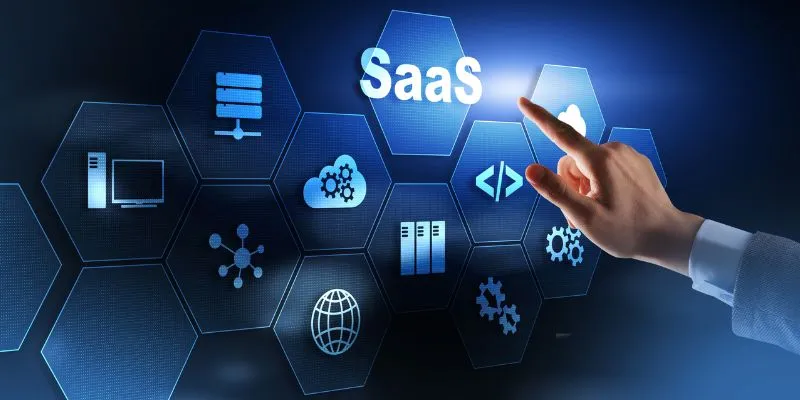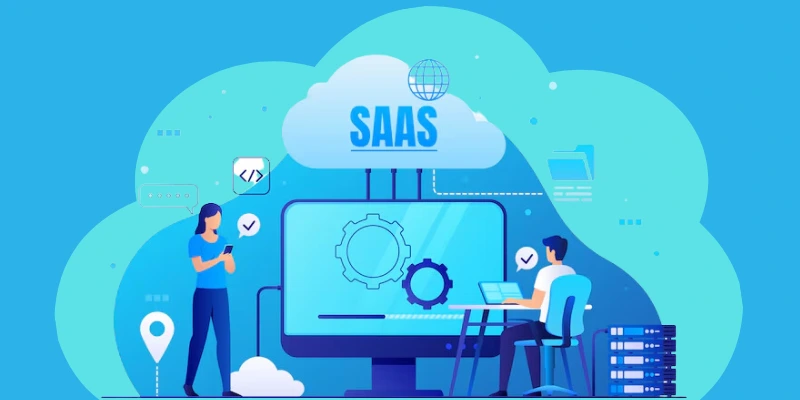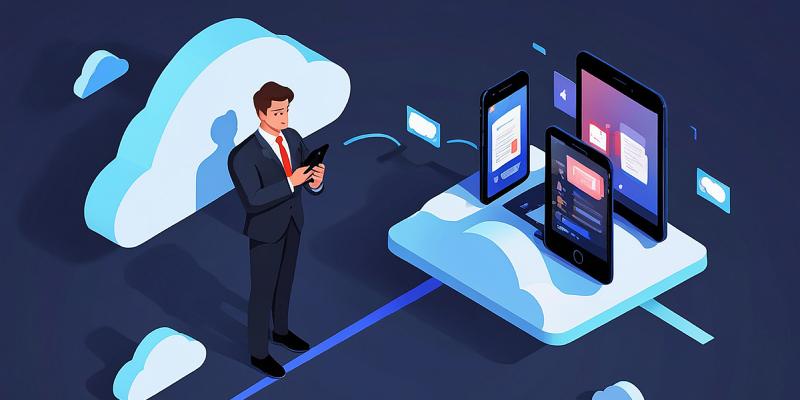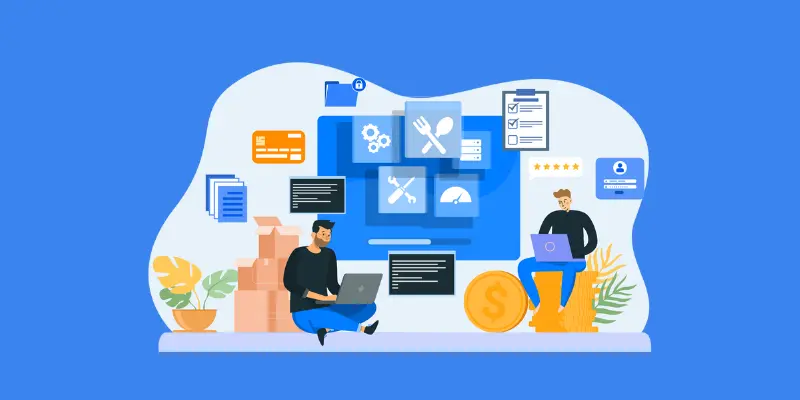Nowadays, businesses are centered on apps and software. However, the same software demands equipment, infrastructure, and skilled staff. This is a problem for IT departments that are overloaded with personnel, resources, and money. However, SaaS Development Services is a solution to several of these issues.
Software as a Service (SaaS) has emerged as an increasingly reliable option for construction organizations looking for increased accessibility, functionality, and adaptability in an ever-evolving business landscape. Companies working in construction can use SaaS software and online data analysis without dependence on installing and operating applications on their personal computers or data centers. This is why this revolutionary technology is growing in popularity each year.
SaaS has now taken over the cloud computing market. SaaS is a distribution software system that provides excellent flexibility and value for the business. It is a highly reliable choice for various sectors and business models, like construction. Also, it is popular with businesses due to its ease of use, accessibility to users, safety, and ubiquitous connectivity. In turn, software-as-a-service platforms streamline business models, resulting in maximum efficiency across the board.
What Is SaaS?
SaaS (Software as a service) is an online service that provides pre-designed software to clients via mobile apps or internet browsers. Customers must buy the program and install it onto their PCs. Users typically sign up for the program through a pay-as-you-go model, usually with a monthly or annual subscription cost. Users also do not require application maintenance since it's automatically updated with the latest features and security updates.
Clients do not need to install or set up this type of service since the SaaS Development Agency manages it. There are some distinctions between creating a SaaS product and traditional services. A SaaS developing company will always work if a SaaS service is released. It is essential to update products regularly to gain more users and be ahead of competitors.
Key Characteristics Of SaaS
Before we explore our essential software-as-a-service trends for 2024, we must consider what defines SaaS as a technological development and a working business model.
Lower Costs
SaaS is an excellent option for cost savings since it typically operates in a shared multi-tenant setting, where software and hardware licensing costs are lower than in the conventional model. A further benefit is that it is easy to increase the number of customers you serve because SaaS lets small and mid-sized companies utilize software they might otherwise not use because of the cost of licensing. Maintenance costs are also lower, as the SaaS company owns and shares the infrastructure with every customer using the software.
Scalability
Cloud-based SaaS allows organizations to proliferate because of its inherent capacity for scaling. Businesses can choose the features they want and the features they'd like.
Updates
SaaS service providers manage essential software updates and develop exciting features as time passes. Therefore, companies don't require massive amounts of time and effort in this particular area of business.
Accessibility
Through SaaS, businesses can access apps from any device or location, which makes them ideal for mobile devices. It also offers a user-friendly interface.
It Is Simple To Implement And Conduct Proof-Of-Concept Tests
SaaS services are simple to utilize since they include best practices baked into the software and examples. Customers can conduct proof-of-concept to evaluate the software's functionality and a brand-new feature ahead of time. You can also use multiple instances of several versions and make a one-click transition. For large-scale environments, you can use SaaS options to evaluate the software before purchasing.
Adaptability
Because of the nearly inexhaustible scaling and the accessibility and insights SaaS advancements provide, businesses that utilize such tools or platforms will be more able to adapt to constant changes or unexpected organizational obstacles.
Improved Collaboration
SaaS innovations enhance the capability to encourage collaboration across departments and groups through the convenience of file sharing and the ability to read and comprehend among platforms.
Security
Many SaaS solutions are renowned for their security at the enterprise level and provide an overall method of security compared to traditional, on-premises systems. When you use Cloud SaaS, pre-existing disaster recovery procedures are implemented to handle the possibility of system failure. This means your company's information is safe and available in case of a security breach or a system malfunction.
Steps Of Custom SaaS Development
Let's take a look at the checklist of the stages of the software-as-a-service application development life cycle:
Idea Generation And Validation
Ideation and validation are key to creating your product. Ideation involves coming up with ideas and then sharing them with the development team. However, validation involves confirming the idea's potential before implementing it in the main development. Although the startup is responsible for initial idea testing, the development partner handles the technical elements.
UX/UI Design
UX/UI design of SaaS products involves both phases: user experience design and interface design. It is important to remember that every symbol, button, or shape on the design is an extra system characteristic. Also, drawing a button can be significantly faster and more affordable than designing one. Behind every button, you can conceal numerous logical connections between entities, calculations, and connections.
Therefore, be cautious when designing during the minimum viable product phase to keep your budget within the limits. Also, it is important to note that the designs are used to accurately determine the development price and break down the development process into stages.
Coding And Testing
The purpose of creating SaaS applications is the ability to transform an idea into a functioning platform. Designers provide UX/UI design and style files.
-
The backend engineer creates all the required code to allow these features to function.
-
Frontend developers upload the style to the server. Then, the front end with the back end.
-
The QA tester designs and conducts tests to identify and report bugs and manage the fixes.
-
The project manager is responsible for the whole procedure from beginning to end, overseeing and coordinating all aspects.
In truth, it's difficult to accurately explain the development process because different companies use different methods and standards.
Launch And Maintenance
In this instance, you'll deploy the SaaS platform through GitHub, AWS CodeCommit, or a different launch platform. DevOps engineers are experienced in helping software navigate the launch phase and carry out the core task. Following that, maintenance will begin. However, one of the biggest mistakes made by tech entrepreneurs during this stage is not setting aside an appropriate budget to cover maintenance. This should be sorted right from the beginning stage of planning.
Product Scaling
It is essential to note this before moving on. Most founders do not even think about it. However, you must attract prospective customers during the testing stage. You're likely among the founders who consider this. We'll continue to follow the idea that you'll already have the first clients once you have launched your platform. The best thing you can accomplish in this stage is continuously collecting customer feedback. There are various ways to do this, including interviews, questionnaires, email comments, etc.
How To Find a Reliable SaaS Development Partner
Identifying the best development team is mostly dependent on creating a successful SaaS solution. If you had the most lucrative idea you've ever had when technology became widespread, choosing the wrong group could make your concept unworkable.
We'll explore the best ways to find an honest partner
Relevant Expertise
Before hiring a SaaS development team, evaluating their previous jobs and understanding their complexities is vital. Creating a perfect SaaS solution requires more than techniques; the team must know the marketplace. Select only a team that demonstrates an in-depth knowledge of your business model and Software-as-a-Service technologies.
Portfolio Of Work
Each offer you receive is from a development team that claims to be the best. However, by browsing through their portfolios, you can determine what they can offer you based on their list of work. If you're looking for SaaS, ensure you know the specifics of the previous cloud computing projects they've worked on.
Live Successful SaaS Completed Projects
In addition to the portfolio, watch out for the success rate of previous software-as-a-service it built. If there's room for expansion, look at other projects with the potential for creating another SaaS offering.
Common SaaS Development Challenges
We'll take a look at some of some of the most well-known errors that you and your team could be faced with.
Reliability
Cloud software maintenance is a must for cloud software maintenance. The AWS SaaS architecture provides reliable service. AWS is accountable for the hardware and maintains an archive of all the files. This is a crucial aspect of using AWS as a SaaS solution. Your customers should depend on the services you provide and be able to trust them. Therefore, it is essential to be attentive to the specifics like logo design, UI/UX style, and color.
Integrating Third-Party Services
An average SaaS app contains many features built by third parties and integrated via APIs. The payment system is one of the most prominent third-party features in SaaS software. This feature facilitates subscription payments or performs monetization/pricing-related tasks for users. This is a problem because integration may be complex. After all, the technical requirements can be very complicated. Popular payment services integrating into SaaS platforms include Stripe, QuickPay, Braintree, and Skrill. Due to their complex nature, payment services with API instructions provide users with guidance during implementation processes.
Hiring an experienced development team with expert QA personnel and manual/automated tests for third-party integration, both manual and automated, to ensure it works flawlessly. Your choice of integration type depends upon what's key to the function of your SaaS platform.
Building a Secure Database
SaaS applications contain a massive quantity of confidential data that is accessible on any device that has an Internet browser with an option to enable it. This increases the risk of hacking. To guard against this, SaaS database service providers employ SSL and TLS as standard encryption protocols to protect user-to-server communication and communications between two clients.
Yet, this protection needs to sufficiently ensure the security of the data processed through SaaS solutions. To provide data security, the world is making laws governing developments and how the platform's management is carried out. It is now up to startups to identify and transfer their development processes with SaaS development firms that understand the complexities and nuances of HIPAA and GDPR protocol. The development team must adhere to these guidelines when they begin developing.
Ensuring No-Downtime Deployment
The primary focus should be on updating the platform frequently. One challenge is that platforms are often unavailable during maintenance times. When conducting an update, traditional systems inform users of the downtime. As Software-as-a-Service platforms must remain continuously operational, their maintenance teams typically opt for an uninterrupted deployment strategy. One of the most well-known strategies for avoiding downtime is to use a blue-and-green approach.
The model of release for the application is a method of transferring users regularly between versions of the software to a new version, and both are available. The earlier version of the software is named the blue-colored environment; in contrast, the more recent version is referred to as green. The blue one can be used as a backup in the event of a problem in one or to create a model for the next version.
The Top SaaS Trends In 2024

Now that we've explored the critical characteristics of software-as-a-service innovations, it's time to dive deeply into the top SaaS trends in 2024. From introducing artificial intelligence to improved mobile optimization, this list of SaaS trending areas is transforming the field.
Artificial Intelligence
The most significant trending areas we have seen in SaaS are the self-learning and autonomous self-learning types. At present, Artificial Intelligence (AI) is deeply rooted in the arteries of our lives and is rapidly becoming an established SaaS market standard. AI-powered innovations give organizations across sectors the capacity to provide better products, services, or content customization while getting an understanding, based on data, of the demands of their target audience. A perfect mix of higher returns for less input suggests that, with AI com, panties can be more effective and innovative by using fewer resources.
AI technology has witnessed some significant changes. This was mainly in the area of Generative AI (GenAI). Many SaaS companies have embraced the technology to boost their services. As an example, following the worldwide impact of ChatGPT and the web-based design software, Canva has introduced a function that allows users to design with AI. AI and machine learning often offer more responsiveness and interactivity for business-related scenarios between customers, businesses, and technology. AI is driving SaaS trending in 2024 and beyond towards the next stage.
There are many features designed by contemporary software vendors built on artificial intelligence, such as alerts to data. Utilizing the help of an AI algorithm that employs the most sophisticated neural network to detect anomalies and a machine-learning algorithm to aid in pattern recognition, alerts can recognize patterns and trends and inform you when something significant occurs. When you meet a set goal or if something unexpected happens, it will notify you, allowing you to have an eye on your business. It is tough to track what is essential when so many KPIs are being monitored. Online reporting software can monitor your data, inform you of fluctuations or changes, and notify users when they stray from its intended course.
Artificial Intelligence is expected to improve the core aspects of the SaaS model in different ways. If SaaS is paired with AI abilities, it allows companies to get more value out of their data, streamline and personalize their services, enhance security, and augment humans' capabilities.
Machine Learning
Machine Learning (ML) is one of the subsets of AI used in SaaS to increase responsiveness to customer service reports and other applications that use AI, like chatbots that operate with live chat. This will also streamline the onboarding process for SaaS. Because ML is based on an operational model of autonomous operation advancements, it will enable software and platforms that allow enterprises to automatize significant portions of internal functions beyond customer service and user experience.
An influx of ML innovations will enable services to self-improve and provide efficiency and intelligence that will propel many sectors ahead. Machine learning is among the fastest-growing segments of software and, as such, is today's most popular SaaS subject. As ML becomes integral to the AI-based software-as-a-service model, more platforms will emerge to help businesses across sectors.
Integration
At the beginning of SaaS, finding integrated options was impossible. The services and products could not be joined. This meant that customers were expected to use other third-party solutions, which was not appealing to institutions and users, particularly those not ready to transfer their information into a cloud service like AWS.
In reality, many SaaS companies can offer more integration options, which attracts companies looking for a hybrid platform that integrates a cloud backend with an on-premise. SaaS integrations are beneficial because they eliminate a significant amount of human error by partially automated processes. Tools can be a good illustration of this seamless automation. The tool can seamlessly integrate various platforms, including CRMs, email clients, and more.
Micro SaaS
As previously mentioned, competition in the SaaS scene is getting fiercer and more numerous. Since more new players join the market, we are beginning to notice many businesses seeking to change and adopt an innovative and imaginative method of providing their clients with the needed services. One method of adjusting to the current competitive landscape is to develop small, flexible, and scalable products typically run in small groups or even one person.
Micro SaaS services generally are additions or extensions to more extensive services designed to improve customer experience in specific areas. As they have lower risks and are relatively cheap to manage, we may witness a significant increase in micro SaaS products, specifically those designed to cater to smaller customer segments and niches.
Low-code apps
In recent years, platforms for development that do not require code have been on everyone's radar, and the SaaS market is no exception. Low-code services have a greater reach for users of every age as they permit smaller "tech" startups and individuals to get into the game, which allows them to expand the market.
The accessibility is awe-inspiring and comes with numerous advantages. Less code means lower cost, which means that designers, developers, and product managers can devote their time and resources to innovation and addressing the industry's most pressing problems. Also, low-code platforms let SaaS Development Company create rapid MVPs that allow faster testing of more ideas.
The Vertical SaaS
As the title suggests, vertical SaaS offers solutions for various industries. In contrast, horizontal SaaS seeks to appeal to a smaller segment of people, generally within a particular area of expertise. Its increased flexibility can increase revenue and reduce customers' acquisition costs.
Data-as-a-Service (DaaS)
Over the last few years, organizations large and small have been utilizing data to make the most crucial strategic decisions. The growth in data, coupled with the evolving business landscape left behind by the pandemic, has made the utilization of data a necessity rather than a decision. The problem is that storing and managing data within the company has been ineffective and more vulnerable. That's where Data-as-a-Service (DaaS) is in the picture. It is positioning itself as one of the leading SaaS developments for 2024.
DaaS refers to cloud-based applications that manage data, including data storage, collection, integration, analytics, and more. It allows companies to cut down on the time necessary to make crucial decision-making decisions, both operational and strategic, and enhance the accuracy and security of their database. Furthermore, it dramatically reduces the cost and time involved in creating processes and tools for data across the entire organization since cloud BI instruments are much simpler to set up than on-premise ones.
The market is becoming more competitive. By 2024, DaaS instruments will continue to create advanced features that help make data use safer and more effective for companies from all sectors. Datapine is data-centric software that provides users easy access to a range of BI options, like dashboard reports and predictive analytics powered by artificial intelligence, live data access in real-time, report sharing, and more.
Although this may sound great, DaaS providers will also confront challenges that must be resolved to provide top-quality services. Security is the most important aspect of the checklist. Since DaaS will require users to share sensitive data, encryption technology is required to safeguard the information.
Migration To PaaS
As the software-as-a-service industry evolves and innovation increases, many developers or providers will prioritize customer retention over acquisition. That said, during 2024, we expect SaaS to migrate further towards the realms of PaaS (platform as a service) developments that empower businesses to build custom apps as add-ons to their original services. Salesforce and Box have recently introduced PaaS-based services to maintain the market with a large share of their market, which we believe will cause this SaaS trend to be more commonplace in the coming years. One of the primary goals of the PaaS development in 2024 will be to help startups and small businesses grow successfully and quickly.
The Rise Of SaaS super Apps
In the wake of the market consolidation we discussed, we may see the development of SaaS super apps as a significant trend for 2024. Remembering that a "super app" is more than an app offering numerous features and services within an interface is essential. It is an architecture and application that can be commodifiable and allow for multiple integrations unrelated to each other. It can be integrated into one single app.
By 2024, this pattern will likely gain more traction, particularly within the SaaS B2B space, in which enterprises are expected to build "One API for all" by unifying multiple APIs to create one. This happens with Alloy Automation, a no-code integration platform with more than 200 apps. It is designed to assist entrepreneurs, marketers, and agencies in streamlining procedures in fields.
Conclusion
The SaaS (software-as-a-service) market is proliferating. It is predicted that by 2030, it will hit $908 billion, and the annual growth rate will increase from 18 percent to 18.7 percent. Many companies choose to use SaaS as a SaaS model owing to the cost savings, enhanced capacity, and improved security. Therefore, if you're wondering how to create your own SaaS service, this guide can assist you.
As complicated as the SaaS development process is essential for businesses and customers. Making SaaS solutions facilitates seamless user experience since they can use the software anywhere by connecting to the internet. The benefits of this are not only added to the company that offers SaaS but also lowers the cost of their services.
In the future, SaaS applications will likely integrate certain of the most recent technological trends. For example, artificial intelligence-enhanced cloud applications will likely become the norm over the next few years. Also, as Internet of Things (IoT) devices increase in use at manufacturing facilities and warehouses, expect to see SaaS applications that work better with IoT.














Share this blog